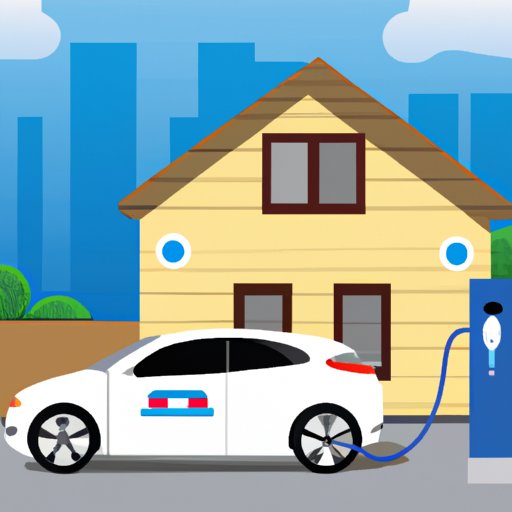Introduction
As the electric vehicle (EV) industry continues to grow, many people are considering purchasing an electric vehicle and charging it at home. Home charging offers several advantages over public charging stations, such as convenience and cost savings. This article will explore the benefits of charging a car at home, compare it to charging at public stations, and provide tips on troubleshooting and maintenance.

Overview of the Benefits of Charging a Car at Home
Charging an electric vehicle at home has several advantages. The most obvious benefit is the convenience factor; you can charge your car whenever you want, without having to worry about finding a public charging station. Additionally, home charging is typically cheaper than public charging, as you can take advantage of lower utility rates. Finally, home charging also allows you to reduce your carbon footprint by using renewable energy sources.
Overview of the Necessary Equipment for Home Charging
In order to charge your electric vehicle at home, you’ll need to invest in some specialized equipment. First, you’ll need an electric vehicle charger, which is used to connect your car to the power supply. Next, you’ll need to install a dedicated circuit for the charger, as well as any other necessary wiring. Lastly, you’ll need to ensure that your electrical system is up to code and able to handle the additional load.
Comparing Home Charging to Public Charging Stations
When deciding whether to charge your electric vehicle at home or at a public charging station, there are several factors to consider. Home charging is typically more convenient, as you don’t have to worry about finding a public station or competing with other drivers for access. Additionally, home charging is usually cheaper, as you can take advantage of lower utility rates. On the other hand, public charging stations offer faster charging times, as they typically have higher amperage chargers. Additionally, public charging stations may offer incentives, such as free charging or discounted rates.
Examining the Necessary Equipment for Home Charging
In order to charge your electric vehicle at home, you’ll need to invest in some specialized equipment. There are two main types of chargers available: Level 1 and Level 2. Level 1 chargers are the slowest and cheapest option, but they require a 120-volt outlet, which may not be available in all homes. Level 2 chargers are more powerful and faster, but they require a 240-volt outlet and are more expensive. Additionally, you may also need to install additional wiring and circuits, depending on your home’s electrical system.

Exploring the Cost Savings of Home Charging
One of the major benefits of charging your electric vehicle at home is the potential cost savings. Home charging typically requires less electricity than public charging stations, so you can take advantage of lower utility rates. Additionally, you can also save money in the long run by taking advantage of time-of-use rates, which can significantly reduce your electricity costs. Finally, you can also save money on maintenance costs, as home charging eliminates the need for frequent trips to the gas station.
Exploring the Environmental Impact of Home Charging
Another benefit of home charging is the potential to reduce your carbon footprint. By using renewable energy sources, such as solar panels or wind turbines, you can significantly reduce the amount of carbon emissions associated with charging your vehicle. Additionally, home charging eliminates the need for gasoline, which is a major source of air pollution. Finally, home charging can also reduce water usage, as electric vehicles don’t require regular oil changes like traditional cars.

Exploring Safety Issues with Home Charging
When charging your electric vehicle at home, it’s important to take safety precautions. First, make sure that the charger and any other equipment is installed correctly, according to local codes. Additionally, use proper grounding techniques to minimize the risk of electrical shock. Finally, never leave the charger unattended while it’s in use, and always unplug it when not in use.

Providing Tips on Troubleshooting Home Charging Issues
If you’re having trouble charging your electric vehicle at home, there are a few steps you can take to diagnose and fix the problem. First, check the circuit breaker to make sure it hasn’t been tripped. If it has, reset it and try again. If the problem persists, check the wiring for loose connections or damaged insulation. If necessary, hire a professional electrician to inspect the wiring and make any necessary repairs.
Conclusion
Charging an electric vehicle at home offers several benefits, including convenience, cost savings, and environmental impact. Additionally, by investing in the necessary equipment and taking safety precautions, you can ensure that your home charging experience is safe and reliable. Ultimately, home charging is an excellent way to save money and reduce your carbon footprint.
(Note: Is this article not meeting your expectations? Do you have knowledge or insights to share? Unlock new opportunities and expand your reach by joining our authors team. Click Registration to join us and share your expertise with our readers.)
